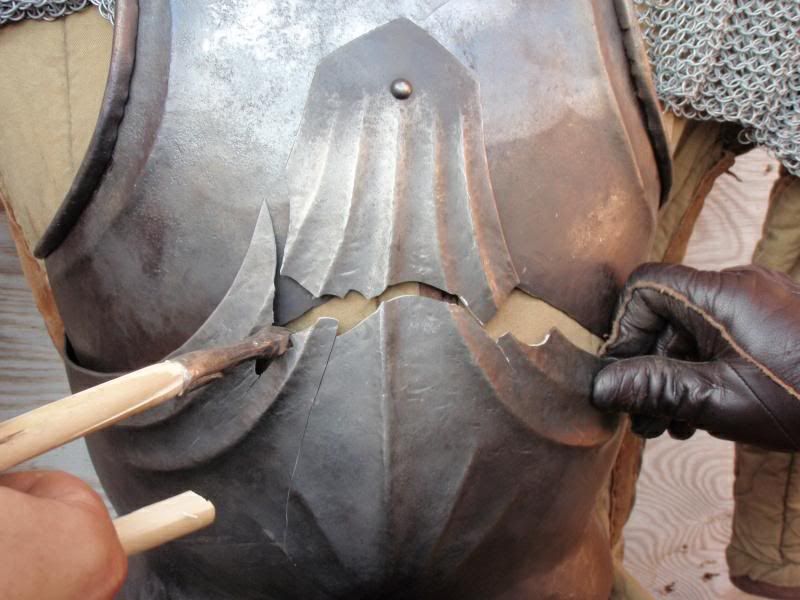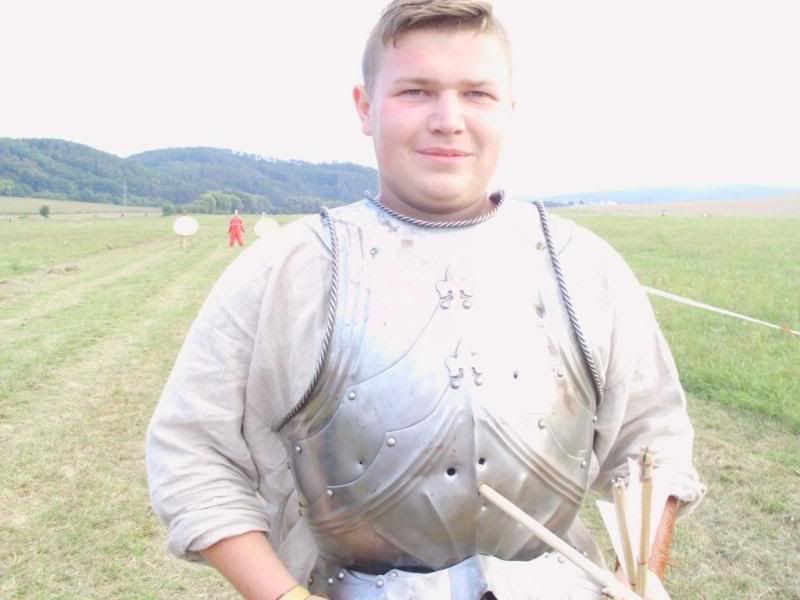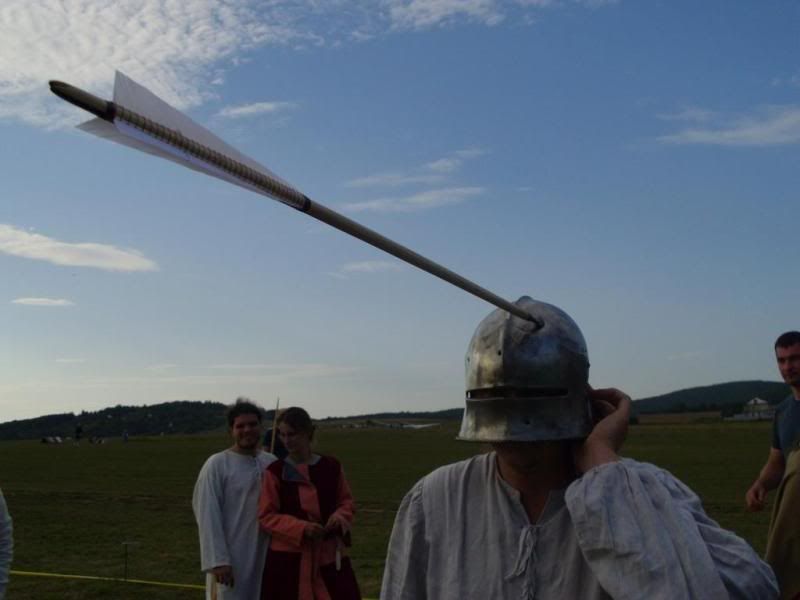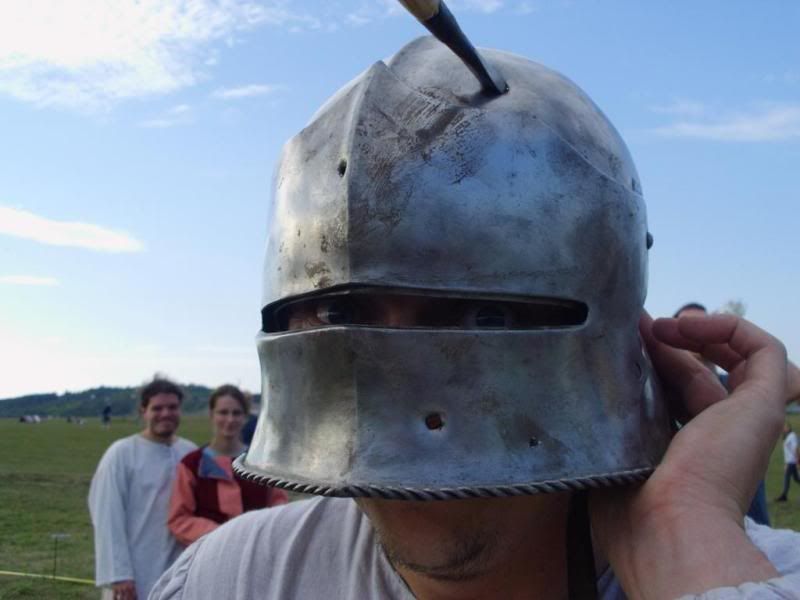|
|
| Author |
Message |
English Warbowman

Location: Hawkes Bay
|
 Posted: Sat Oct 01, 2011 9:16 pm Armour too brittle, armour too soft Posted: Sat Oct 01, 2011 9:16 pm Armour too brittle, armour too soft |
 |
|
Enjoy.





 |
|
|
 |
tank

Location: foxton
|
 Posted: Sun Oct 02, 2011 8:33 pm Posted: Sun Oct 02, 2011 8:33 pm |
 |
|
where did you find these pics?
regards
tank
_________________
custom built plate armour |
|
|
 |
English Warbowman

Location: Hawkes Bay
|
 Posted: Mon Oct 03, 2011 6:38 am Posted: Mon Oct 03, 2011 6:38 am |
 |
|
Hi Tank.
I got the pics from the English warbow forum. They were taken by Jaro Petrina in the Czech Republic at an event that he helps organize.
The brittle plate was made by Jiri Brozek. It was hit by a bolt from a 250lb crossbow. Don't have info on the maker of the other stuff but they were hit by 100g+ arrows from bows around the 120lb draw weight. |
|
|
 |
Oskar der Drachen

Location: Masterton
|
 Posted: Mon Oct 03, 2011 7:19 am Posted: Mon Oct 03, 2011 7:19 am |
 |
|
May I re-post the pictures to the Armour Archive?
Jiri is a minor legend in the Armouring world. It is entirely relevant to some of the discussions going on over there. |
|
|
 |
English Warbowman

Location: Hawkes Bay
|
 Posted: Mon Oct 03, 2011 6:10 pm Posted: Mon Oct 03, 2011 6:10 pm |
 |
|
| No worries Oskar. I asked Jaro if I could post on a public forum so now that they're out there I don't think its an issue. |
|
|
 |
crite40
Location: Helensville Rodney
|
 Posted: Mon Oct 03, 2011 11:09 pm Graphic armour failures Posted: Mon Oct 03, 2011 11:09 pm Graphic armour failures |
 |
|
Many thanks to the poster. You have given support to a view I have long held about the actual combat protection afforded by real plate armour.
Far too many historians have taken the view that a man in plate was almost invulnerable to contemporary missile weapons. Perhaps they might have been persuaded otherwise if they had been wearing the armour!
My historical specialty has always been the history of technology and I have always been of the opinion that armour was overrated. Medieaval blacksmiths and armourers didn't have the advantage of a modern steel mill.
Every piece of plate had to be hammered out and tempered with a simple charcoal forge. It would have been quite impossible, even for an expert, to get equal strength and temper over something as large as a breastplate for example. Anything larger than a sword blade would be beyond their ability to fully control strength and temper.
If only more bits of armour had survived that had been used in combat.
I reckon we would find a lot of catastrophic failures by shattering and penetration just like these.
Sure, it was a damn sight better than nothing. But these sights remind you of why those "mere peasant" archers fingers were cut off by the aristos!!! |
|
|
 |
English Warbowman

Location: Hawkes Bay
|
 Posted: Tue Oct 04, 2011 6:34 am Posted: Tue Oct 04, 2011 6:34 am |
 |
|
| I can see this thread descending into one of the many armour V missile arguments. So just in case it does here's my 10 cents worth about missle penetration. Sometimes they did, sometimes they didn't depending on a whole host of variables. |
|
|
 |
Terme
|
 Posted: Tue Oct 04, 2011 4:07 pm Posted: Tue Oct 04, 2011 4:07 pm |
 |
|
| The helm actually looks like it did a decent job all things considered and with padding it may not have even cut skin? would have been one heck of a blow and knocked anybody on their butt. |
|
|
 |
JohnF

Location: Palmy
|
 Posted: Fri Oct 07, 2011 8:35 pm Posted: Fri Oct 07, 2011 8:35 pm |
 |
|
| English Warbowman wrote: | | I can see this thread descending into one of the many armour V missile arguments. So just in case it does here's my 10 cents worth about missle penetration. Sometimes they did, sometimes they didn't depending on a whole host of variables. |
You posted the pictures! Do you have any information on:-
- Thickness of steel
- Type of steel
- The manufacturing process of the armour
- The distance from bow to target
- How the armour was held as a target
- What was behind the armour
- The depth of penetration
I echo Terme's statement. Given a choice between being knocked off my
feet or dying from an arrow through my brain, I'd choose the former. |
|
|
 |
Mad Jim

Location: Dunedin
|
|
|
 |
English Warbowman

Location: Hawkes Bay
|
 Posted: Fri Oct 07, 2011 9:35 pm Posted: Fri Oct 07, 2011 9:35 pm |
 |
|
John, if you read the title it says armour too brittle armour too soft which is why it ended up the way it did. That title by the way is not mine, it was written by Jaro Petrina from the Czech republic. I don't know any details of the armour apart from the brittle piece being made by Jiri Brozek who apparently is a well known armourer. I can however from observation say that the arrow was shot from close range due to the angle of impact. This has been done to enable a hit on the target not to ensure penetration as it would have the same result at long range due to the arrow reaching near terminal velocity in its descent.
The arrow head (helmet photos) is known as a lozenge head which was developed as a counter to the proliferation of plate armour in the second half of the 100 years war. It's particular quality is to not deflect on a curved surface which can be seen in the photos. They average about 8cm in length so it looks like it has penetrated about 2cm. The arrow looks like it weighs around 100g.
What's commonly overlooked is that there was a large variation in arrowhead quality just as there was in armour. The best heads were case hardened (known as steeled) which obviously had better penetration capabilities, which brings me to my point, sometimes arrows penetrated sometimes they didn't. Anyone who argues exclusively for one side or the other is ignorning the primary accounts of the period which say the same and modern testing under scientific conditions which were conducted by Mark Stretton at the UK Defence Acadamy in Shrivenham, Oxfordshire.
http://www.sylvanarchery.co.uk/SUNDRIES/warbowdvd.html
From the testing that's been carried out on various forms of armour by the EWBS the conclusion is that a well made brigandine has the best resistance to warbow arrows. |
|
|
 |
JohnF

Location: Palmy
|
 Posted: Sat Oct 08, 2011 8:12 pm Posted: Sat Oct 08, 2011 8:12 pm |
 |
|
| English Warbowman wrote: |
What's commonly overlooked is that there was a large variation in arrowhead quality just as there was in armour. The best heads were case hardened (known as steeled) which obviously had better penetration capabilities, which brings me to my point, sometimes arrows penetrated sometimes they didn't. Anyone who argues exclusively for one side or the other is ignorning the primary accounts of the period which say the same and modern testing under scientific conditions which were conducted by Mark Stretton at the UK Defence Acadamy in Shrivenham, Oxfordshire.
http://www.sylvanarchery.co.uk/SUNDRIES/warbowdvd.html
From the testing that's been carried out on various forms of armour by the EWBS the conclusion is that a well made brigandine has the best resistance to warbow arrows. |
Forgive me my questions Keith. I'm as ignorant as they come.
I've added that DVD to my shopping queue. It's always interesting to see
videos of tests. What is useful about tests is that it helps us understand
which armour would be the best choice for a given circumstance.
Without doing any tests, your argument has merit. The ancients liked to
win and they liked to stay alive. Therefore they would do the best they
could to protect themselves, and to penetrate the defences of their
enemies. At any battle during the 100 years war both sides thought it
worthwhile to have both missile troops, and to have the best armour that
money could buy.
I imagine the ideal angle of attack would be perpindicular to the plate,
yes? How much more of deviation from 90 degrees can a lozenge shaped
tip accept before being deflected, compared with other popular tips? |
|
|
 |
English Warbowman

Location: Hawkes Bay
|
 Posted: Sat Oct 08, 2011 9:37 pm Posted: Sat Oct 08, 2011 9:37 pm |
 |
|
90 degrees is the ideal John. It's quite remarkable however how well the lozenge shape bites into plate at what seems to be very difficult angles. I've lost my copy of the dvd unfortunatly although I know Aaron has one so he might be able to help us out with the actual number of degrees.
When you look at the major battles of the 100 years war you can see the arms race between armour and missiles ( as well as hand weapons) developing which in turn is influencing the tactics being used by both sides. For several reasons though the French never managed to use their missile troops effectively. |
|
|
 |
tank

Location: foxton
|
|
|
 |
|
 Please read the terms of use
Please read the terms of use
 Contact the Site Admin
Contact the Site Admin







